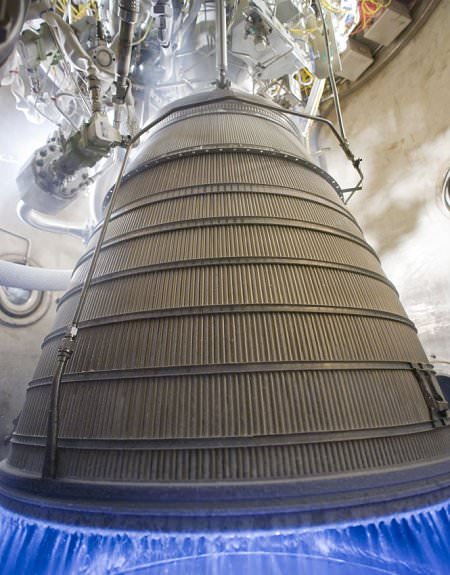[/caption]
Yes, you’re seeing this image correctly. There are icicles forming at the rim of this rocket engine bell, and this particular engine generates a scalding 2,760 C (5,000 F) degree steam and a whopping 13,000 lbs of thrust. How can that happen? Cryogenics. NASA is developing the engines that will be used for the next generation lunar lander, the Altair. These engines are called the Common Extensible Cryogenic Engine (CECE). CECE is fueled by a mixture of -182 C (-297 F) liquid oxygen and -253 C (-423 F) liquid hydrogen. The engine components are super-cooled to similar low temperatures–and that’s where the icicles come from. As CECE burns its frigid fuels, hot steam and other gases are propelled out the nozzle. The steam is cooled by the cold nozzle, condensing and eventually freezing to form icicles around the rim. Watch the video.
More about the engine.
CECE, is a deep-throttling engine, which means it has the flexibility to reduce thrust from 100 percent down to 10 percent — allowing a spacecraft to gently land on the lunar surface. During the test, the engine was successfully throttled from a high of 104 percent of the engine’s potential down to eight percent, a record for an engine of this type. A cryogenic engine is needed to provide high performance and put more payload on the surface of the moon. The CECE demonstrator has evaluated two engine configurations during three rounds of hot-fire testing.
The tests are being done by Pratt & Whitney Rocketdyne in West Palm Beach, Florida. This was the third test for these engines. Previous tests in 2006 and 2007 showed the engines needed some fine tuning. Tony Kim, Deep Throttling Engine project manager at NASA’s Marshall Space Flight Center, Huntsville, Ala, said, “Testing in 2007 provided an in-depth examination of low-power-level throttling and engine performance characteristics. This third cycle we actively addressed and found solutions to the challenges we faced.”
The team carefully assessed test results that showed pressure oscillations in the engine at lower throttle levels called “chugging.” Chugging may not be a concern for the engine itself, but the resulting vibrations could have the potential to resonate with the structure of the rocket and cause problems for the lander or crew.
Injector and propellant feed system modifications successfully eliminated engine chugging by controlling liquid hydrogen and liquid oxygen flow to the combustion chamber. The latest engine configuration incorporates a new injector design and propellant feed system that carefully manages the pressure, temperature and flow of propellants. And it seemed to work quite well.
Cool!
Source: NASA


That’s so cool.
Literally.
How do you get 104 percent of an engine’s potential? Isn’t that like eating 104 grams of a 100 gram chop? Where do the extra 4 grams come from?
I was under the impression that all engines always worked under their potential. No?
@ Jorge:
My guess is they estimated the engine was only so powerful, but under testing they found that it actually went above what they had predicted.
@Jorge:
The engine’s rated capacity is lower than it’s absolute capacity. It is generally the difference between the ‘safe’ maximum and the mechanical maximum.
Ah. I see. Thanks for clearing this up for me.
That was awesome. Ive got to get me one 😉
Actually, when space shuttle pilots hear “Go at throttle up”, it means they have passed max q and the main engines are going to throttle from 65% to 104%…
This is sweet, but would the fact that engine components need to be kept at cryogenic temperatures limit it to extra-atmospheric use?
Windows Media Player – I am so sick of the U.S. Government using my tax dollars to sanction microcrap corporation.
I think the point is that it’s an engine designed for the hardships of space. A place where hot and cold simply don’t work in the ways we landsiders are used to.
Linux — use VLC, is plays .asx files just fine and it’s GNU GPL
“This is sweet, but would the fact that engine components need to be kept at cryogenic temperatures limit it to extra-atmospheric use?”
Not really. The Space Shuttle Main Engine (SSME) is also a hydrogen-oxygen burner, as are the engines in the Delta IV first stage. (and many other rockets use liquid oxygen as the oxidizer, which is still pretty cold stuff, though not so much as liquid hydrogen)
And the CECE is a modified RL-10, the first production LOX/H2 engine, first designed in the early 1960s for the Centaur upper stage. A throttleable version, modified for sea-level operatios was also used in the DC-X program to test single stage to orbit technologies…
http://en.wikipedia.org/wiki/RL-10
I had always hoped that the Centaur/RL-10 might one day be modified into a reuseable orbit-to-orbit space tug, including a Lunar landing capability..I may yet sort of get my wish.
Boy pretty scary choice to use complex cryogenics for landing on the moon. There is a reason storables were used last time, with an ultra simple engine… We dont want people stranded on the moon or to have them crash land.
My amp goes to 11.
Its kinda weird to use this kind of technology for jet propulsion but i guess it works so be it.
Does anybody know what’s the difference between this CECE and SSME which Space Shuttle use? Both use liquid oxygen and hydrogen, both have cooled nozzle etc…